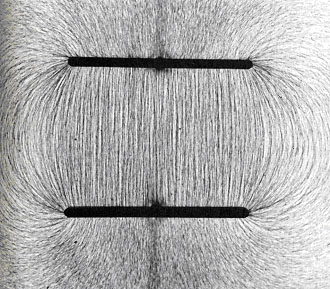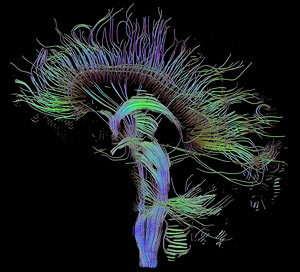My view on consciousness
There are two metaphorical roads to approach the enigma of 'sensing matter'. Both arrive at the same building, one at the front, the other at the rear. So far it has been impossible to pass the building - inside or outside - in order to meet the entrance at the other side.
The objective, experimental and outer-directed route ends in the visible brain, but any visitor keeps circulating in the maze of neural networks, synapses and cell microtubuli. This is the preferred road of deductive science.
Travellers in the subjective landscape of sensation and thought dwell in the holistic illusions but lack clear indications and there is nobody to ask, as they travel on their own. Sooner or later they get lost, too...
In order to overcome our dualistic paralysis in theorizing about the nature of awareness, we need to have a closer look at this dilemma and relate first person (phenomenology) and third person (deductive science) approaches on the subject, without denying the dualistic nature of consciousness. Consciousness is always awareness of something, if not of itself, aknowledging a differentiation between content and container. Possibly this duality is a product of our differentiating and categorizing consciousness itself, thus maybe an illusion. The main knowledge tools of our mind - logics and imagination - may not suffice to tackle the problem.
Yet I invite the readers to follow my reasoning and formulate critical questions, leading to either increased insights and understanding or its scientific death penalty...
The nature of knowing
Let us consider now the relation between the existence of something (ontology) and the knowledge we can obtain about it (epistemology). Our only way to get access to reality is by isolating phenomena through perceptual categorisation, further aided by higher-level categorisation made possible by language. These gives us the means of interrelating perceived phenomena at higher cognitive levels and learning more about their mutual interactions and relations.
In whatever description of reality we need to realize that the categorical, discrete character of symbolic languages (and even lower-level perception) only points at an inpermanent and highly intra-active reality without the artificial borders that our knowledge system imposes on it.
Just as any categorisation about, say, social life phenomena, like 'the Muslim', 'warfare' and 'Muslims make warfare' are by definition an impoverishment with regard to real life, which is too complex to describe in a realistic way in common daily language, so we encounter these categorical limitations in science as well. As long as we use these categorisations as operational models that refer to ontological processes, without substituting for (even the subtlest details of) it, we can learn from reality without violating her.
As we have no other means than discrete language, we should continue using it in its most fruitful way, which implies also acknowledging its limitations.
Our only way of knowing aspects of reality is by taking a single perspective at any moment. What we then know is our (at best 'shared') representation of a single point of view. For example, we can look at a tree (that is: our limited, categorical, internal perceptual representation of it) from various points in space, thus hypothesising how the ontological real tree out there 'is'. The more we zoom in, the more aspects we will discriminate. On the smallest possible scale we probably see just nothingness (empty space with invisible energy). So then what is the real tree? Do we really catch its identity by summing up all our observations on all possible scales? And is there still an entity on the smallest scale or do the atoms and electrons vaguely merge into the environment of the supposed tree?
These considerations will appear to be important when we come to speak about consciousness.
The Self-referenced Unified Information Field - an approach
The existence of any biological or physical 'object' (its 'being') can be considered as an information field, where many processes occur simultaneously and are interrelated. Here, an object refers to any group of molecules with a certain structure, without specifying its exact boundaries other than given by our perceptual system and the resulting naming conventions. But even though there is always interaction between processes, like flows of electrons and changing chemical relations, and whatever the intensity of these interactions, there can be no emergence of consciousness without an overarching unification of information in which parallel processes - as well as sub-processes about their mutual interactions - are integrated into a larger context. Only with the existence of such a field in which simultaneous present information is fed back to its components, a process of self-referencing, subjective consciousness can emerge, given the appropriate organic architecture to make these interactions possible. It seems therefore unlikely that such fields occur spontaneously in objects other than complex animals.
A characteristic of consciousness is that the body implicitly experiences itself as a unity and as a constant, in response to continuous change inside itself, including changes in the senses. The senses are part of the body that sample information from the environment. The brain then 'calculates' its conclusions, including a response, and 'translates' these into qualia. These are suitable to form part of a SSUIF by merging with other qualia and at the same time keeping their own identity. Sameness and change thus coexist in any experience.
Access to information
Consciousness can be seen as the potentially parallel availability of a variety of specific information, aspects of which can be accessed by attention processes but only in the context of the simultaneously available overall picture (the unified information field). Consciousness thus arises as an emergent phenomenon from foreground-background interactions. Consciousness is basically self-awareness, which means awareness of one's own body. Sensory stimulation leads to this self-consciousness, too, through changes in body experience. Thus, even for example vision is an aspect of body experience (signalling changes in the environment), namely a change in the SUIF as a result of sensory stimulation.
These changes are constantly moving flows of specific information (foreground processes) forming all together in a parallel way the SSUIF and derive their meaning from the feedback from the SUIF to that specific information streams. Thus the network structure of the SSUIF makes it possible to get access to associeted information that (dynamically) can become part of the SUIF itself.
Awareness drops when there is little or no change in the input flows to the SUIF. This happens for example in sensory deprivation and snow blindness. The interactions between the SUIF and its constituent streams of information are constantly changing and therefore essential to raise awareness. The SUIF itself is not synonymous with consciousness, but is what we subjectively experience as consciousness. Consciousness is thus a necessary epiphenomenon of a dynamic phenomenon, namely the registration of moving information flows in interaction with the SUIF, which itself is a (parallel and temporally synchronized) composition of those information flows. This does NOT imply a secondary role for the important process it shadows, as some opponents of epiphenomenalism suggest. Further, consciousness implies both parallel and serial processing of information.
Qualia
A great mystery to this theory remains the emergence of qualia, being 'vehicles' responsible for the differentiation of information. It is unclear how we will ever be able to understand qualia, as the process of understanding itself it based on 'qualitative' experience. But we might discover the neural mechanisms underlying their phenomenology.
On the phenomenological side there is no interference between qualia, which may indicate that the neural coding of any quale is discrete at a very basic level. Qualia are probably coded in the primary cortices, as research to synaesthesia suggests.Qualia help us differentiate between informational states. They emerge out of specific, discrete coding processes of action potentials that arrive from the senses in the primary cortices and that are modulated by top-down feedback streams of information, like that from the hippocampus. These neural codings and their emergence as qualia in consciousness 'make the difference' and it is the changing interaction between these differences in the presence of stable references, supplied by (hippocampal) memory networks, that give significance to our lives. They deal with the content of consciousness and by that with the content of our lives.
Consciousness itself as a binding phenomenon gives us a 'total picture' access by the formation of a unified information field that is maintained by neuromodulation in the brainstem, giving it the right supply of energy necessary for its enduring integrity.
Without that, the field falls apart, losing thereby its emergent characteristics. This doesn't mean that all of its constituent processes decrease their activity, too. The brain never sleeps completely. At a critical level of network activity consciousness emerges necessarily from intensive information exchange and 'melting' of discrete information streams to a coherent field, while preserving their qualiative content at the same time.
Consciousness correlates with arousal (activation level) that seems to play a role in global signalling (and thereby binding) of discrete, so far unconscious and distributed brain processes. Crucial is the 'implicit self' that figures as a constant (like the global body image) or 'ground' for consciousness. This should not be confused with the 'explicit self' that equals with self-consciousness.
Space consciousness
We feel our legs 'down there', our back 'behind' and our head 'here on top'. Patients keep these sensations even after amputation of a body part (phantom pain). This reminds us that the sensation is generated in the brain but projected back by consciousness to a specific place in the body. The same is true for our internal representations of outer space, which we identify with the real world out there. It is an aspect of the integrative nature of consciousness and its function to monitor the body (self) in its spatial environment (non-self). The 2D spatial organisation of the retina and subsequent topographical ordering of the visual cortex (V1) underscores the link between the brain as a representational system and the 3D reality to which it refers. The brain only has to do the trick of transforming 2D encoding to 3D experience, which is done by multi-modal sensory integration.
Summary
Consciousness is a necessary and illusory aspect of an energy consuming process of linking and integrating extremely differentiated streams of information in a unified and unique field, which is possibly electromagnetic by nature.
The field contains multiple merged and mutually interrelated information streams about body processes that are kept active as well as interrelated in neural loops. These information streams that are constantly updated by intensive and widespread feedback, are referenced to their own individual as well as to their interactive history.
Specific coding processes of neural signals lay on the basis of differentiation of information into qualia (and their complexes that give consciousness its content and significance) and guarantee to preserve its identity.
The processes underlying this unified informational field (identical to the neural correlates of consciousness) are self-regulating by their strong top-down feedback loops. These also explain the relative constancy and selectiveness of conscious content.
The energy to maintain this field is produced by the body metabolism and regulated by brainstem and thalamic processes.



